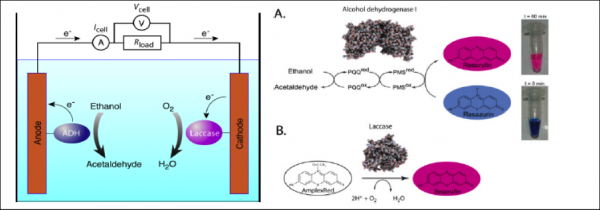Yousr Skhiri
Yousr Skhiri- PhD Student started October 2007.
Project.
Digital microfluidic systems for the directed evolution of catalysts for biofuel cells
Our final goal is to build a functional bio-fuel cell using enzymes as redox catalysts at the anode and cathode. To achieve this goal the key points are a high catalytic activity of these enzymes at high ethanol concentrations, broad pH and temperature variations and their stability at the interface with the electrodes. These are conditions under which the natural enzyme will never evolve in vivo. Hence, we are aiming to apply in vitro protein evolution methods in combination with digital microfluidics to create better catalysts for the "green energy" production.
The expenses concerning "green energy" production might be overcome by availability of better bio-catalysts. In the most common way biofuel, in form of ethanol, is obtained from sugars stored within the plants such as corns, sugarcane.
Schematic configuration of a biofuel cell based on redox enzymes and the fluorogenic tests for measuring the activity of the biocatalysts in droplet: (On the left) ethanol is oxidized to acetaldehyde by alcohol dehydrogenase (blue ellipse). During oxidation, electrons from ethanol are transferred onto the anode via PQQ cofactor, while protons are released into the media. At the cathode, electrons are transferred to immobilized laccase (purple ellipse), which catalyzes oxygen reduction to water in the presence of copper ions. (On the right) panel A: the fluorogenic assay for the PQQ-ADH: in the presence of ethanol, the Pyrroloquinoline quinine (PQQ) cofactor and the PMS (Phenazine MethoSulfate: electron mediator), resazurin is converted to resorufin. (On the right) p anel B: the fluorogenic assay for the laccase: in the presence of oxygen, AmplexRed is converted to resorufin. Taken from Skhiri et al., Proceedings MicroTas 2010.
For a successful evolution of ADH using digital microfluidics, my project consisted on addressing the following challenges:
- Development of Droplet-based microfluidic high-throughput selection procedures for directed evolution of ADH
- Detailed characterization of surfactants used in digital microfluidic experiments (including analysis of biocompatibility of surfactants to ensure high enzymatic activities as well as protein expression in droplets)
- Analysis and characterization of leakage of small molecules (especially fluorophores that are used to identify positive events) among droplets
- Optimization of ADH for Biofuel cell applications
In parallel, I am also involved in a project aiming at the highly sensitive detection of Cancer Biomarkers in droplets.
Publications.
Multi-step microfluidic droplet processing: kinetic analysis of an in vitro translated enzyme. Mazutis L., Baret, J. C., Treacy, P., Skhiri, Y., Fallah-Araghi, A., Ryckelynck, M., Taly, V. and Griffiths, A.D. Lab on a Chip (2009), 9: 2902-8.
Quantitative and sensitive detection of rare mutations using droplet-based microfluidics. Pekin, D., Skhiri, Y., Baret, J.-C., Le Corre, D., Mazutis, L., Ben Salem, C., Millot, F., El Harrak, A., Hutchison, J.B., Larson, J.W., Link, D.R., Laurent-Puig, P., Griffiths, A.D. and Taly, V. Lab on a Chip. (2011), 11(13): 2156-66.
Biocatalytic conversion of wheat bran hydrolysate using an immobilized GH43 beta-xylosidase. Smaali, I., Rémond, C., Skhiri, Y., O'Donohue, M.J. Bioresour Technol. (2009), 100(1): 338-44.
Proceedings
Integrated microfluidic platform for directed evolution of laccase for Biofuel cell applications. Skhiri, Y., Beneyton, T., El Harrak, A., Griffiths, A.D. and Taly, V. In: Proceedings of the 14th International Conference on Miniaturized Systems for Chemistry and Life Sciences (MicroTAS), 2010, p. 980-982. ISBN: 978-0-9798064-3-8.
Droplet-based microfluidics for the quantitative detection of rare mutations. D. Pekin, Y. Skhiri, Baret, J.-C., Le Corre, D., Mazutis, L., Ben Salem, C., El Abed, A., Hutchison, J.B., Link, D.R., Griffiths, A.D., Laurent-Puig, P. and Taly, V. In: Proceedings of the 14th International Conference on Miniaturized Systems for Chemistry and Life Sciences (MicroTAS), 2010, p. 58-60. ISBN: 978-0-9798064-3-8.
Fundings
Région Alsace and Fondation d’entreprise EADS (see http://www.fondation.eads.net/fr/support-research-project_digital-microfluidic).
Curriculum Vitae
Collaborations
Dr Jean-Christophe Baret. Droplets, Membranes & Interfaces Group. Max Planck Institute for Dynamics and Self-organization. Goettingen, Germany.



